Continued from Part Three –The Vyuha
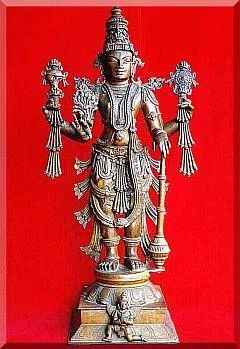
F. Vyuhantara
Vyuhantara
19.1. In the Pancharatra schema of cosmology, Para is the undifferentiated Vasudeva while Vyuha is the stage of differentiated creation closer to the beings. Lakshmi Tantra (4:25-32) a Pancharatra text of about the tenth century explains “First there is only the substance (reality); then comes the state of being; next the creation; and then the activity”.
19.2. The text elaborates that right after the final stage of Vyuha evolution and the onset of jagrat (wakeful) state of existence, each of the four Vyuha produced three further forms that resembled their creators (Vyuha) in all respects.
19.3. Accordingly, from Vyuha -Vasudeva, Keshava, Narayana and Madhava emanated; from Sankarshana emanated Govinda, Vishnu and Madhusudana; from Pradyumna emanated Trivikrama, Vamana and Sridhara; and from Aniruddha emanated Hrishikesha, Padmanabha and Damodara.
19.4. Vyuha is the major formation and the twelve forms that emanated from it constitute the secondary formation; and therefore known as upavyha or vyuhantara, which literally means ‘the one that within the Vyuha’.
Maasa Devatha
20.1. Each of the twelve Vyuhantara is identified with a month and is revered as masa-devatha (lord of the month).And; collectively they are identified with the year.
|
Vyuha
– the source
|
Vyuhantara
form
|
Shakthi
or
the consort
|
Maasa
the month
|
|
Vasudeva
|
Keshava
|
Sri
|
Margashira
|
|
Narayana
|
Vagishvari
|
Pushya
|
|
|
Madhava
|
Kaanthi
|
Magha
|
|
|
Sankarshana
|
Govinda
|
Kriya
|
Phalguna
|
|
Vishnu
|
Shanthi
|
Chaitra
|
|
|
Madhusudana
|
Vibuthi
|
Vaishakha
|
|
|
Pradyumna
|
Trivikrama
|
Iccha
|
Jesta
|
|
Vamana
|
Prithi
|
Ashada
|
|
|
Sridhara
|
Rathi
|
Shravana
|
|
|
Aniruddha
|
Hrishikesha
|
Maaya
|
Bhadrapada
|
|
Padmanabha
|
Dhi
|
Ashviyuja
|
|
|
Damodara
|
Mahima
|
Karthika
|
|
20.2. It is also said that the twelve Vyuhantara along with their source (four) together make sixteen ; and are symbolic of the phases of the moon “Shodasha kala) ; andthis also is a measure of Time.
Vyuhantara -Adityas – Sun -Vishnu
21.1. In the ancient Indian context, Year is identified with empherical Time, which in turn is identified with the Sun. Because, the Sun in its daily course defines the day (and night), the basic (shortest) unit of time and governs life.
[The shortest unit was obtained by dividing the day/night into eight equal parts and each eighth into sixty and each sixtieth into sixty again. One third of that resultant unit was kshana (three consecutive eyelid moments – roughly a second).
24 hours in a day X 60 minutes = 1,440 minutes; that is divided into 8 parts; each such part being equal to 180 minutes; which is divided into sixty units = each unit being 3 minutes or 180 seconds; and that is divided by 60 = 3 seconds; and that again is divided into three micro units = about one second (three consecutive eyelid movements)]
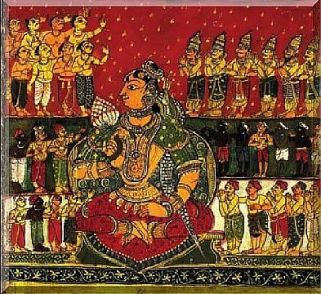
[Aditi is revered as the Deva Matri, the mother of all gods. In a way, all the gods are Adityas – children of Aditi. The Adityas, who represent light are gods of light (Divi, Devas); bright and pure as streams of water; blameless; and, free from all guile and falsehood. The Adityas are upholders of Laws,” Upholding that which moves and that which moves not; and, are the protectors of all beings”.
Lord Vishnu was originally a solar deity (Addition); and, was later elevated to the status of a trinity God as the preserver of the world, to rescue the world and the dharma from the oppression of evil and social disorder.
Varuna, at one time, was regarded as the best among the Adityas, the solar deities; he was the lord of the sky; the god of heavenly light. But now, Surya (Savitr), the sun god is the most prominent Aditya. He is said to be endowed with many eyes (rays) corresponding to the twelve months of the year , described as the twelve spokes of the wheel of time.
*
The number as also the names of Adityas have varied from time to time. Originally, they were said to be to be six or seven in number, as per the hymns of Rig-Veda: Varuna, Mitra, Surya (Savitr), Chandra, Pusan, Agni, and Indra. And, Martanda was the eighth Aditya; but, was later left out.
The Brahmana texts list the twelve Adityas as : Yama; Aryaman; Indra; Ravi; Varuṇa; Dhātṛ; Bhaga; Savitṛ; Sūrya or Arka; Aṃśa; Mitra; and, Dakṣa.
In another listing, Dhatri, Mitra, Aryaman, Rudra, Surya, Bhaga, Vivasvat, Pushan, Savitur, Tvashtir and Vishnu mentioned as Adityas.
The Linga Purana names the twelve Adityas as : Brahma;Vishnu;;Indra (The head of Ādityas); Tvaṣṭṛ; Varuṇa;Dhata; Bhaga; Savitṛ; Vivasvat; Amshuman; Mitra; and, Pūṣan.
According to Bhagavata Purana, the twelve Adityas are : Vishnu (The head of all the Adityas); Aryaman; Indra; Tvashtha; Varuna; Dhata; Bhaga ; Parjanya (Savitr); Vivasvan ; Amshuman; Mitra; and, Pushya.
According to Vishnu Purana, the Adityas are : Vishnu (This solar-deity is the head of all the Adityas); Aryaman; Śakra; Tvaṣṭṛ; Varuṇa; Dhūti; Bhaga; Savitṛ; Vivasvat; Aṃśa; Mitra; and , Pūṣan.
Later , their numbers and names almost, settled down to twelve (Dwadasha Aditiya) as : Dhata ; Aryama; Mitra; Varuna; Indra; Vivasvan; Tvashtha; Vishnu; Amshuman ; Bhaga; Pusha; and, Parjanja.]
21.2. The Vedic deities associated with the Sun and the energy are the twelve (Dwadasaha) Adityas, each controlling a month and collectively a year. They are the spokes of the wheel of Time. The twelve Vyuhantara therefore came to be identified with the Adityas.

With that the Vyuhantara came to be identified also with the empherical Time conceived as yearly cycles. And, thus, Vyuhantara are indeed the Sun.
21.3. Vishnu is the chief of the Adityas; and he is also identified with the Sun. The Vyuhantara, by extension, came to be recognized as the Adityas who in turn are the aspects of the Sun and Vishnu.
21.4. The identity of the Vyuhantara with the Adityas is discussed in detail in the Tantric texts such as Prapanchasara (12th century), Saradatilaka (14th century) and Tantrasara (16th century).
21.5. It is explained that the importance assigned to the twelve Vyuhantara is because of their identity with the Adityas, the Sun and Vishnu. And, their worship is indeed the worship of Vishnu as the Sun.
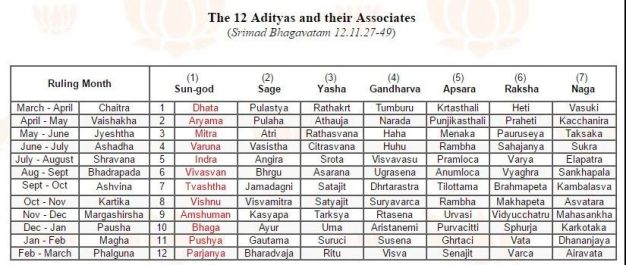
Dwadashamurti
22.1. Mainly by virtue of its association with the Sun and Vishnu, the Vyuhantara or Upavyuha or the Dwadasha-murti (the twelve forms) is an indispensable part of the Sri Vaishnava daily prayer –sandhya vandanam– which essentially is Sun worship; and of the daily purification rite of investing the designated upper-body parts with the Vishnu insignia, the urdhva pundra. Each upavyuha is associated with a specific spot: Keshava – forehead; Narayana-lower abdomen(centre); Madhava-chest; Govinda-front neck (middle) ; Vishnu-lower abdomen (right); Madhusudana-right arm; Trivikrama-neck(right side);Vamana-lower abdomen (left); Sridhara-left arm; Hrishikesha-neck(left side); Padmanabha-back (lower spine); Damodara-back (upper spine); and concluded with salutations to Vasudeva –top of the head.
The appropriate Upavyuha is invoked through anga-nyasa (gestures) with devotion and reverence while investing each set of urdhva-pundra.
22.2. As regards their iconography, the Dwadasha-murtis all resemble the four-armed form of Vasudeva in jagrat (wakeful) state. And, ichnographically they are alike; each possess four arms, carries the same or almost the same Vaishnava insignia (ayudha) – the conch (shankha), the discus (chakra), the mace (gada) and the lotus (padma); they have pleasing countenance (saumya vaktra); they stand erect (sama-bhanga) on lotus pedestal; and wear yellow silk garment (pitambara), royal crown, regal ornaments and flowing garlands of flowers (vanamala). Their color or complexion, are derived from their source vyuha, which is the vyuha among the four (chaturvyuha) from which they originated.
22.3. All the Dwadasha murtis are depicted as solitary images, standing alone; yet each of them is associated with a Shakthi, a consort. Each Shakthi is regarded a form of Lakshmi.
22.4. The forms are differentiated by the order of the four ayudhas or insignia (shankha, chakra, gada and padma) they hold. The Padma Samhita (kriyapada: 16, 30-36) as also Lakshmi Tantra and others describes in detail the iconographic features of the Vyuhantara-murtis. There are again variations among those texts. Let’s talk of that in the last segment of this post.
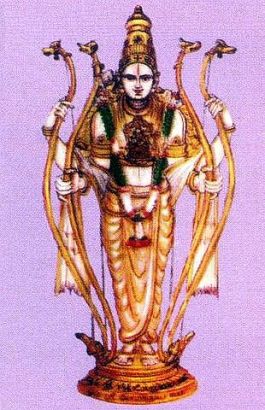
Caturvimsati murti
23. 1. The emanation process did not cease with the twelve Vyuhantara. Padma Samhita (Jnana kanda: 2, 26- 28) mentions that the four Vyuha ‘ for some reason’ went on to create a sub –secondary Vyuhantara forms numbering twelve in two sets (4+8).This was achieved in a rather strange manner. Here, Vyuha- Vasudeva manifested another Vasudeva who manifested Nrusimha who in turn manifested Acchuta.
Sankarshana manifested another Sankarshana who gave raise to Purushottama who in turn manifested Adhokshaja.
Pradyumna manifested another Pradyumna who manifested Janardana who in turn manifested Upendra.
And Aniruddha manifested another Aniruddha who manifested Hari, who in turn manifested Krishna.
23.2. Thus the celebrated Caturvimsati murti group (the twenty-four forms) is composed by:
(a). The twelve Vyuhantara or secondary forms:
[1.Keshava;2.Narayana;3.Madhava;4.Govinda;5.Vishnu;6.Madhusudana;7.Trivikrama;8.Vamana;9.Sridhara;10.Hrishikesha;11.Padmanabha;and 12.Damodara]
(b). Plus the four forms:
[13. Sankarshana; 14. Vasudeva; 15.Pradyumna; and 16.Aniruddha]
(c). And, the eight further (sub secondary) emanatory forms:
[17. Purushottama; 18. Adhokshaja; 19. Nrusimha; 20. Acchuta; 21. Janardana; 22. Upendra; 23. Hari; and 24.Krishna]
24.1. The iconography of the latter set of twelve (from 13 to 24: from Sankarshana to Krishna follows that of the Dwadasha-murtis (from 1 to 12: from Keshava to Damodara). As regards their colour, they follow the colour or the complexion of their source, that is: The first group of three along with Vasudeva is white; the second group along with Sankarshana is ruby red; the third group along with Pradyumna is golden yellow; and the fourth group along with Aniruddha is dark.
25.1. Padma Samhita states that the images of these twenty-four deities should be established in temples in order to acquire merit and prosperity. They might be established either separately or together. But, sculptural representation of all the forms is extremely rare. They are seen only in a few temples of Hoysala period (c.11th century).
25.2. While performing the daily Sandhya it is customary to recite the names of these twenty-four forms and invoke them in the twenty-four spots in the body.
25.3. The Gayatri- Sara- Samgraha, it is said, identifies of the twenty-four letters of the Gayatri Mantra with the deities (abhimana devatha) presiding over the names of the Caturvimsati murtis.[Please see the table appended.]
25.4. It is said the Vyuhantara from 13-16 though they bear the names of the original Vyuhas, they are not the same; they are different. Similarly, it is clarified that Vyuhantara murti with names such as Krishna, Narasimha, Trivikrama, Narayana etc should not be mistaken for the original deities bearing those names. It is also clarified that although the names of Vyuhantara forms resemble the names of Vishnu, ichnographically or otherwise they are NOT the Vishnu.
25.5. Among these twenty-four forms, the set of first twelve Dwadasha- murti, (from Keshava to Damodara), is assigned greater importance than the latter twelve.
*****
Iconography of the Dwadasha murti
1.1. As mentioned earlier, the Vyuhantara murtis are ichnographically similar; they all resemble the four armed Vasudeva in jagrat state. They are differentiated by the manner they hold the four ayudhas or Vaishnava insignia (shankha, chakra, gada and padma).There is however no uniformity among the various texts .For instance, Tantra Sara draws up an elaborate scheme by taking the conch (shankha) symbolizing emancipation as the principle ayudha and works out various positions/ combinations of the other three ayudhas in relation to shankha in upper right hand, shankha in upper left hand, shankha in lower left hand and shankha in lower right hand. Agni Purana, Padma Purana and Skanda Purana etc propose their own scheme.
1, 2. But the commonly accepted form is the one that is given in the Shilpa text Rupamandana, The order given there commences with the upper -right –hand, then goes on to the upper-left-hand , then down to the lower –left-hand and finally to the lower-right-hand. The flow is clock-wise commencing from the upper-right-hand. The initial configuration is with reference to the ayudhas held by Keshava: Shankha (URH); Chakra (ULH); Gada (LLH) and Padma (LRH). The ayudha-positions of the other vyuhantara are worked out by rotation.
[Please refer to the tables appended for the ayudha-positions of all the twenty-four Vyuhantara forms].
Let’s discuss briefly about the iconography of the Dwadasha murti; that is the first twelve Vyuhantara from Keshava to Damodara.
1. Keshava –Murti
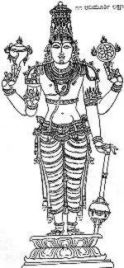 Keshava-murti the first of the Vyuhantara who emanated from Vyuha-Vasudeva is lustrous like gold (suvarna-bha). He wears white garments; and pearl ornaments.
Keshava-murti the first of the Vyuhantara who emanated from Vyuha-Vasudeva is lustrous like gold (suvarna-bha). He wears white garments; and pearl ornaments.
His ayudhas are: shankha (URH); chakra (ULH); gada (LLH); and padma (LRH).
His Shakthi is Sri or Kirti.
He is the Lord of Margashira month.
He is invoked in the forehead of the devotee (lalata).
His flag bears the emblem of the great Eagle (Mahat Garuda Ketana).
2. Narayana- Murti
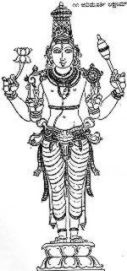 Narayana –murti the second of the Vyuhantara who emanated from Para-Vasudeva is glowing like a dark blue cloud. His countenance is benign (saumya). He wears yellow silk garments (pitambara); and gem studded gold ornaments.
Narayana –murti the second of the Vyuhantara who emanated from Para-Vasudeva is glowing like a dark blue cloud. His countenance is benign (saumya). He wears yellow silk garments (pitambara); and gem studded gold ornaments.
His ayudhas are: padma (URH); gada (ULH); chakra (LLH); and shankha (LRH).
His Shakthi is Vagisvari.
He is the Lord of Pushya month.
He is invoked in the lower abdomen (centre) of the devotee.
His flag bears the emblem of the great Eagle (Mahat Garuda Ketana).
3. Madhava-Murti
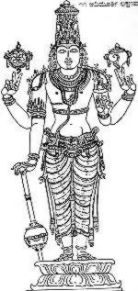 –Murti the third among the Vyuhantara who emanated from Para-Vasudeva shines like blue-lotus (nilothphala) .He dress is multicoloured and is adorned with garlands of many hues. He looks magnificent like a full blossomed lotus.
–Murti the third among the Vyuhantara who emanated from Para-Vasudeva shines like blue-lotus (nilothphala) .He dress is multicoloured and is adorned with garlands of many hues. He looks magnificent like a full blossomed lotus.
His ayudhas are: chakra (URH); shankha (ULH); padma(LLH); and gada (LRH).
His Shakthi is Kanthi.
He is Lord of Magha month.
He is invoked in the chest of the devotee.
His flag bears the emblem of the great Eagle (Mahat Garuda Ketana)-
4. Govinda-Murti
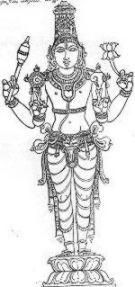 Govinda-Murti the fourth among the Vyuhantara; and the first to emanate from Sankarshana is soothingly bright like moon, like a pearl. His eyes are lustrous and attractive like red lotus. He is adorned in rich gold ornaments.
Govinda-Murti the fourth among the Vyuhantara; and the first to emanate from Sankarshana is soothingly bright like moon, like a pearl. His eyes are lustrous and attractive like red lotus. He is adorned in rich gold ornaments.
His ayudhas are: gada (URH); padma (ULH); shankha (LLH); and chakra(LRH).
His Shakthi is Kriya.
He is Lord of Phalguna month.
He is invoked in the front neck (middle) of the devotee.
His flag bears the emblem of the lofty palm-tree and a plough.
5. Vishnu-Murti
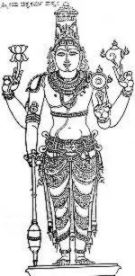 Vishnu-Murti the fifth among the Vyuhantara; and the second to emanate from Sankarshana is crystal white (sphatika). He wears gold coloured bright garments; and richly adorned with ornaments.
Vishnu-Murti the fifth among the Vyuhantara; and the second to emanate from Sankarshana is crystal white (sphatika). He wears gold coloured bright garments; and richly adorned with ornaments.
His ayudhas are: padma (URH); shankha (ULH);chakra (LLH); and gada (LRH).
His Shakthi is Shanthi.
He is Lord of Chaitra month.
He is invoked in the lower abdomen (right) of the devotee.
His flag bears the emblem of the lofty palm-tree and a plough.
6. Madhusudana-Murti
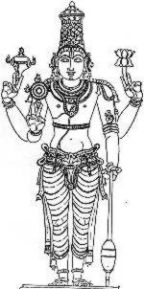 –Murti the sixth among the Vyuhantara; and the third to emanate from Sankarshana is glowing like a red lotus. He wears silken yellow garments. He is richly adorned with ornaments.
–Murti the sixth among the Vyuhantara; and the third to emanate from Sankarshana is glowing like a red lotus. He wears silken yellow garments. He is richly adorned with ornaments.
His ayudhas are: shankha (URH); padma (ULH); gada (LLH); and chakra (LRH).
His Shakthi is Vibhuti.
He is Lord of Vaishakha month.
He is invoked in the right arm of the devotee.
His flag bears the emblem of the lofty palm-tree and a plough.
7. Trivikrama-Murti
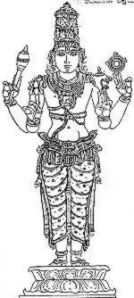 Trivikrama Murti the seventh among the Vyuhantara; and the first to emanate from Pradyumna is glowing like a ruby. He is richly adorned with gold armlets, chains, earrings etc.
Trivikrama Murti the seventh among the Vyuhantara; and the first to emanate from Pradyumna is glowing like a ruby. He is richly adorned with gold armlets, chains, earrings etc.
His ayudhas are: gada (URH); chakra (ULH); shankha (LLH); and padma (LRH).
His Shakthi is Iccha.
He is Lord of Jesta month.
He is invoked in the neck (right side) of the devotee.
His flag bears the emblem of crocodile (Madana)
8. Vamana Murti
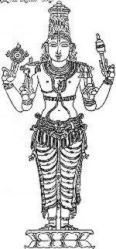 Vamana Murti the eighth among the Vyuhantara; and the second to emanate from Pradyumna is mellow glowing like jasmine , has wide eyes like lotus petals.
Vamana Murti the eighth among the Vyuhantara; and the second to emanate from Pradyumna is mellow glowing like jasmine , has wide eyes like lotus petals.
His ayudhas are: chakra (URH); gada (ULH); padma(LLH); and shankha (LRH).
His Shakthi is Priti.
He is Lord of Ashada month.
He is invoked in the lower abdomen (left) of the devotee.
His flag bears the emblem of crocodile (Madana).
9. Sridhara-Murti
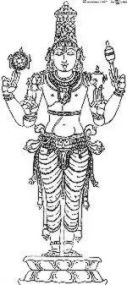 Sridhara-Murti the ninth among the Vyuhantara; and the third to emanate from Pradyumna is lustrous like white lotus. His eyes are beautiful and shining like a red lotus petal. He wears strings of pearls.
Sridhara-Murti the ninth among the Vyuhantara; and the third to emanate from Pradyumna is lustrous like white lotus. His eyes are beautiful and shining like a red lotus petal. He wears strings of pearls.
His ayudhas are: chakra (URH); gada (ULH); shankha (LLH); and padma (LRH).
His Shakthi is Rathi.
He is Lord of Shravana month.
He is invoked in the left arm of the devotee.
His flag bears the emblem of crocodile (Madana).
10. Hrishikesha – Murti
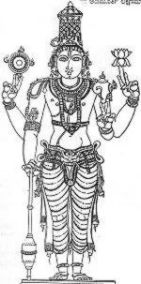 Hrishikesha – Murti the tenth among the Vyuhantara; and the first to emanate from Aniruddha is dazzling like lightning. He wears red garments; red flowered garlands and has stuck a red lotus in his hair.
Hrishikesha – Murti the tenth among the Vyuhantara; and the first to emanate from Aniruddha is dazzling like lightning. He wears red garments; red flowered garlands and has stuck a red lotus in his hair.
His ayudhas are: chakra (URH); padma (ULH);shankha (LLH); and gada (LRH).
His Shakthi is Maaya.
He is Lord of Bhadrapada month.
He is invoked in neck (left side) of the devotee.
His flag bears the emblem of deer (mriga).
11. Padmanabha Murti
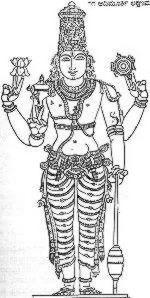 Padmanabha Murti the eleventh among the Vyuhantara; and the second to emanate from Aniruddha is glowing like a blue diamond. He wears bright yellow garments; and is adorned with many coloured gems and jewels; and multihued garlands.
Padmanabha Murti the eleventh among the Vyuhantara; and the second to emanate from Aniruddha is glowing like a blue diamond. He wears bright yellow garments; and is adorned with many coloured gems and jewels; and multihued garlands.
His ayudhas are: padma (URH); chakra (ULH); gada(LLH); and shankha (LRH).
His Shakthi is Dhi.
He is Lord of Ashviyuja month.
He is invoked in back (lower spine) of the devotee.
His flag bears the emblem of deer (mriga).
12. Damodara Murti
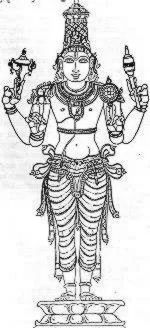 Damodara Murti the twelfth and the last among the Vyuhantara; and the third to emanate from Aniruddha is enchanting like the tender green blades ofdurva grass and wide eyes like pools. He wears yellow silk garments; and many types of gems and jewels; strings of precious stones.
Damodara Murti the twelfth and the last among the Vyuhantara; and the third to emanate from Aniruddha is enchanting like the tender green blades ofdurva grass and wide eyes like pools. He wears yellow silk garments; and many types of gems and jewels; strings of precious stones.
His ayudhas are: shankha (URH); gada (ULH); chakra (LLH); and padma(LRH).
His Shakthi is Mahima.
He is Lord of Kartika month.
He is invoked in back (upper spine) of the devotee.
His flag bears the emblem of deer (mriga).
*****
The following tables indicate the ayudha positions of each Vyuhantara Murti , its presiding deity; and, its association with the letters of Gayatri Mantra.
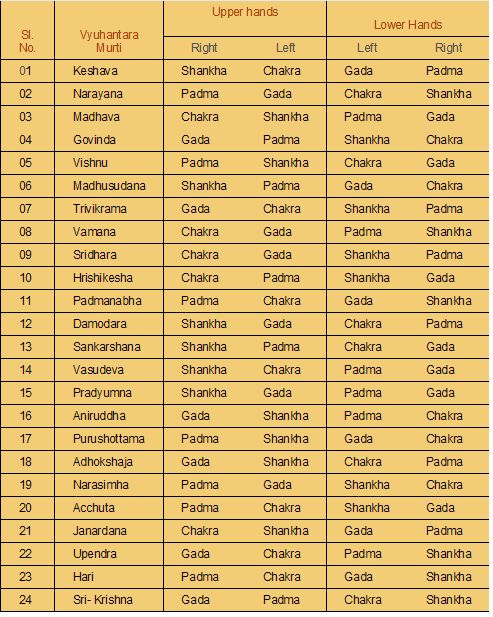
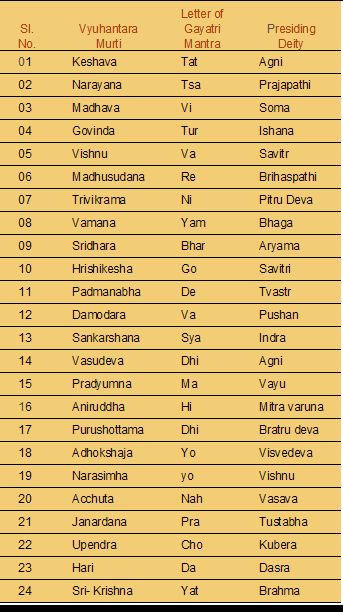
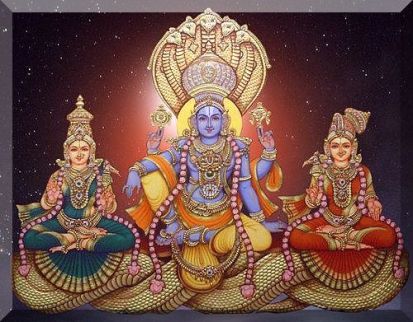
Sources and References
I gratefully acknowledgethe line-drawings and notes fromBrahmiya Chitrakarma Sastram
by Prof G Gnanananda
Vishnu Koshaby Prof.SK Ramachandra Rao
Ritual, state, and history in South Asia By J. C. Heesterman, A. W. van den Hoek, D. H. A. Kolff, M. S. Oort
http://www.wilbourhall.org/sansknet/agama/Pancharatraagama/poushkara_samhita/36.htm
http://www.ramanuja.org/sv/bhakti/archives/feb96/0014.html
http://www.stephen-knapp.com/thousand_names_of_the_supreme.htm
http://www.hindu.com/2001/03/13/stories/13130179.htm
http://www.ramanuja.org/sv/bhakti/archives/jan98/0082.html
http://www.ramanuja.org/sv/bhakti/archives/dec2000/0142.html